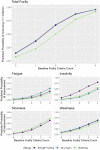This is a preprint.
Can strength training or tai ji quan training reduce frailty in postmenopausal women treated with chemotherapy? A secondary data analysis of the GET FIT trial
- PMID: 37886571
- PMCID: PMC10602129
- DOI: 10.21203/rs.3.rs-3425168/v1
Can strength training or tai ji quan training reduce frailty in postmenopausal women treated with chemotherapy? A secondary data analysis of the GET FIT trial
Update in
-
Can strength training or tai ji quan training reduce frailty in postmenopausal women treated with chemotherapy? A secondary data analysis of the GET FIT trial.J Cancer Surviv. 2024 Aug;18(4):1179-1189. doi: 10.1007/s11764-024-01592-5. Epub 2024 Apr 20. J Cancer Surviv. 2024. PMID: 38642204 Clinical Trial.
Abstract
Purpose: To determine whether strength training or tai ji quan can reduce frailty in older, postmenopausal women treated with chemotherapy for cancer.
Methods: We conducted a secondary data analysis from a 3-arm, single-blind, randomized controlled trial where older (50+ years), postmenopausal women cancer survivors were randomized to supervised group exercise programs: tai ji quan, strength training, or stretching control for 6 months. We assessed frailty using a 4-criteria model consisting of weakness, fatigue, inactivity, and slowness. Using logistic regression, we determined whether the frailty phenotype (pre-frailty or frailty) decreased post-intervention, how many and which frailty criteria decreased, and what characteristics identified women most likely to reduce frailty.
Results: Data from 386 women who completed baseline and 6-month testing were used (mean age of 62.0 ± 6.4 years). The odds of improving overall frailty phenotype over 6 months was significantly higher in the strength training group compared to controls (OR [95%CI]: 1.86 [1.09, 3.17]), but not for for tai ji quan (1.44 [0.84, 2.50]). Both strength training (OR 1.99 [1.10, 3.65]) and tai ji quan (OR 2.10 [1.16, 3.84]) led to significantly higher odds of reducing ≥1 frailty criterion compared to controls. Strength training led to a three-fold reduction in inactivity (p <0.01), and tai ji quan to a two-fold reduction in fatigue (p=0.08) versus control. Higher baseline BMI, comorbidity score, and frailty status characterized women more likely to reduce frailty than other women.
Conclusions: Strength training appears superior to tai ji quan and stretching with respect to reducing overall frailty phenotype among postmenopausal women treated with chemotherapy for cancer, but tai ji quan favorably impacted the number of frailty criteria.
Implications for cancer survivors: Supervised, group exercise training that emphasizes strength training and/or tai ji quan may help combat accelerated aging and reduce frailty after cancer treatment.
Keywords: aging; exercise; neoplasm; physical activity; physical functioning.
Conflict of interest statement
Disclosures: The authors have no competing interests to declare that are relevant to the content of this article.
Figures


References
Publication types
Grants and funding
LinkOut - more resources
Full Text Sources

